Newsletters
- Home
- Publications
- Newsletter Archive
- Newsletter
March/April 2019
Inside This Issue:
- The results are in . . . Survey of Small Town Municipal Officials
- Center Board Welcomes New Members
- Chairman's Message
- Center Board Elects Slate of Officers
- Rural Snapshot: Young Adult Homeowners
- Research Examines Availability of Services in Rural Pennsylvania
- Just the Facts: Bankruptcies
- The Census is Hiring! Jobs Available to Assist with 2020 Census
The results are in . . .
Survey of Small Town Municipal Officials
Pennsylvania’s 2,560 municipalities are governed by nearly 12,800 elected officials. More than 7,100 of these officials, or 56 percent, govern municipalities with fewer than 2,500 residents.
To learn more about these officials and their communities, the Center for Rural Pennsylvania conducted a statewide survey in September 2018 of municipalities with fewer than 2,500 residents. The respondents included borough council members and mayors, and supervisors in township of the second class.
According to the survey results, the respondents have been serving their municipalities for 11.1 years, on average, and they initially sought local elected office because they wanted to be active in the community, were encouraged to serve by others, and wanted to improve their communities. Fifty-four percent said they ran unopposed in their last election, and 67 percent said they planned to run for re-election.
The top three municipal issues cited by respondents were streets and highways, taxes and spending, and financial viability.
Respondents said their municipalities employed 3.3 full-time and 3.5 part-time employees, on average, and 20 percent said their municipality had a manager. Seventy-seven percent of respondents spent less than 20 hours per month on municipal business, including regularly scheduled meetings. Twenty-three percent spent more than 20 hours per month on municipal business.
Seventy-four percent of respondents volunteered in their community. The top three types of volunteer activities were religious organizations, social/civic organizations, and fire companies.
The full results, 2018 Survey of Small Town Municipal Officials, are available on the Center’s website at www.rural.palegislature.us.
Center Board Welcomes New Members
 At its February board meeting, the Center welcomed Rep. Eddie Day Pashinski. Rep. Pashinski serves the 121st District, which includes Wilkes-Barre City, Fairview Township, Wilkes-Barre Township, Ashley Borough, Hanover Township and Laurel Run Borough in Luzerne County. He was first elected to the House of Representatives in 2006, and serves as the Democratic chairman of the House Agriculture and Rural Affairs Committee.
At its February board meeting, the Center welcomed Rep. Eddie Day Pashinski. Rep. Pashinski serves the 121st District, which includes Wilkes-Barre City, Fairview Township, Wilkes-Barre Township, Ashley Borough, Hanover Township and Laurel Run Borough in Luzerne County. He was first elected to the House of Representatives in 2006, and serves as the Democratic chairman of the House Agriculture and Rural Affairs Committee.
Rep. Pashinski is a graduate of Wilkes University, with a degree in Music Education and a master's equivalency. He was a music teacher and choral director at the Greater Nanticoke Area School District.
In March, the Center's board welcomed Sen. Katie J. Muth. Sen. Muth serves the 44th Senatorial District, representing parts of Montgomery, Chester and Berks counties. Sen. Muth serves as the Democratic chair of the Urban Affairs and Housing Committee, and serves as a member of the Finance, Health and Human Services, Intergovernmental Operations and State Government committees. Sen. Muth earned a bachelor’s degree in Athletic Training at Penn State University, and obtained her master’s degree at A.T. Still University of Health Sciences in Mesa, AZ.
Chairman's Message
When discussing policy issues or proposed legislation, I like to know the facts. While anecdotal information certainly contributes to the discussion, I do not base my decisions solely on it. I want more solid information on the issues being considered, and that includes access to reliable data. Often, the Center for Rural Pennsylvania is the source of that data.
Do you know that the Center maintains the most comprehensive statewide database on Pennsylvania €“ and it covers all 67 counties, urban and rural.
This database includes U.S. Census data, covering multiple decades, the U.S. Ag Census, and a host of other federal data sources, including the U.S. Departments of Health and Human Services, and Commerce, and the Centers for Medicare and Medicaid, to name just a few. In addition, the Center tracks data from many state agencies or has cooperative agreements to access their data for research and analysis. Depending on how the data are initially collected, the Center can review, analyze and present them at the county, municipal, and or school district levels.
If you are looking for employment information, the top employers in every county, the number of medical doctors and other healthcare professionals statewide, the number of farms and farmer demographics, the number of young adult homeowners by county (as shown below), or bankruptcy rates across the state and nation (as shown below), the Center is your one-stop contact.
Information from the Center’s database is available to everyone: members of the Pennsylvania General Assembly, state and local government officials and employees, community organizations, educational institutions, businesses, individuals, and the media.
If you’re looking for data, especially as they relate to rural Pennsylvania, click on the “Demographics” menu tab above. And remember, if you do not find what you’re looking for, call the Center at (717) 787-9555 or email info@rural.palegislature.us with your specific data requests. We add and update information regularly as federal and state data are released and as Center sponsored research is finalized. The feature article in this edition highlights the results from an in-house survey conducted on municipal officials in small communities across the Commonwealth.
As we welcome the long-awaited Spring season, I am pleased to also welcome Sen. Katie J. Muth to the Center’s board. Sen. Muth represents the 44th Senatorial District and was appointed to the board in March. I look forward to her participation in the Center’s work.
Senator Gene Yaw
Center Board Elects Slate of Officers
At its meeting on February 4, the Center for Rural Pennsylvania’s Board of Directors re-elected Senator Gene Yaw as board chairman for a full two-year term.
Sen. Yaw, who represents the 23rd Senatorial District, which includes Bradford, Lycoming, Sullivan, and Union counties and portions of Susquehanna County, was first elected chairman in 2011.
Joining Senator Yaw as officers are: Representative Garth Everett, who represents the 84th Legislative District, which includes parts of Lycoming and Union counties, as vice chairman; Dr. Nancy Falvo, who represents faculty from the Pennsylvania State System of Higher Education (PASSHE) universities and teaches the online Bachelor of Science in Nursing Program for Clarion University, as secretary; and Stephen M. Brame, who serves as Gov. Tom Wolf's representative to the board and is vice president of Public Affairs and Members Services for the Pennsylvania Rural Electric Association/Allegheny Electric Cooperative.
The Center’s board also includes Representative Eddie Day Pashinski, who represents the 121st Legislative District, which includes Wilkes-Barre City, Fairview Township, Wilkes-Barre Township, Ashley Borough, Hanover Township and Laurel Run Borough in Luzerne County; Dr. Michael A. Driscoll, president of Indiana University of Pennsylvania; Dr. Lawrence Feick, interim president of the University of Pittsburgh at Bradford and the University of Pittsburgh at Titusville; Dr. Stephan J. Goetz, executive director of the Northeast Regional Center for Rural Development; Dr. Timothy Kelsey, professor of Agricultural Economics at the Pennsylvania State University; and Darrin Youker, director of State Government Affairs for the Pennsylvania Farm Bureau.
Sen. Katie J. Muth joined the board in March. She represents the 44th Senatorial District, which includes parts of Montgomery, Chester and Berks counties.

At its February meeting, the Center's Board of Directors elected officers, and discussed a range of targeted topics for the 2020 Research Grants Program.
Rural Snapshot: Young Adult Homeowners
In this Snapshot, a young adult homeowner is defined as a person under 35 years old who owns the home in which he/she lives.
Homeownership Rates Among Young Adults, by County, 2017
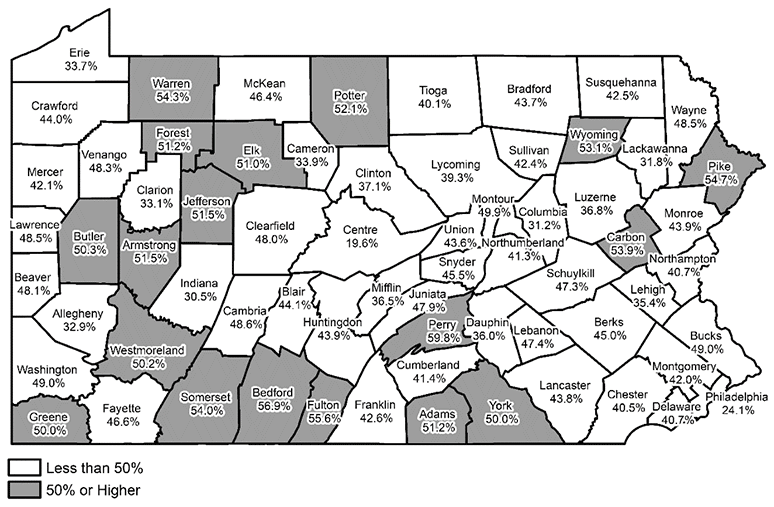
Data source: 2017, 5-year average, American Community Survey. U.S. Census Bureau.
Young Adult Homeownership Rates in Rural and Urban PA, 1990, 2000, 2010, and 2017
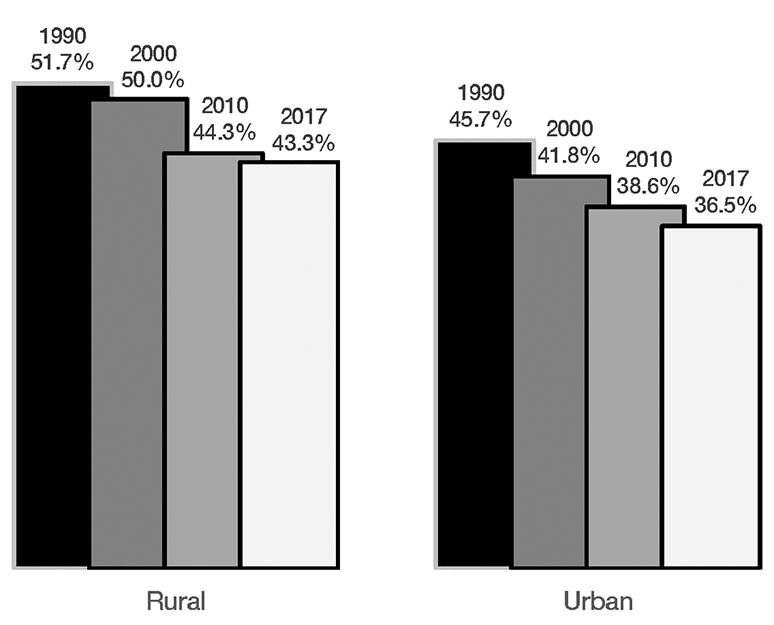
Data sources: 1990, 2000, and 2010 Censuses and the 2017, 5-year average, American Community Survey. U.S. Census Bureau.
Change in Homeownership Among Young Adults, by County, 2010 to 2017
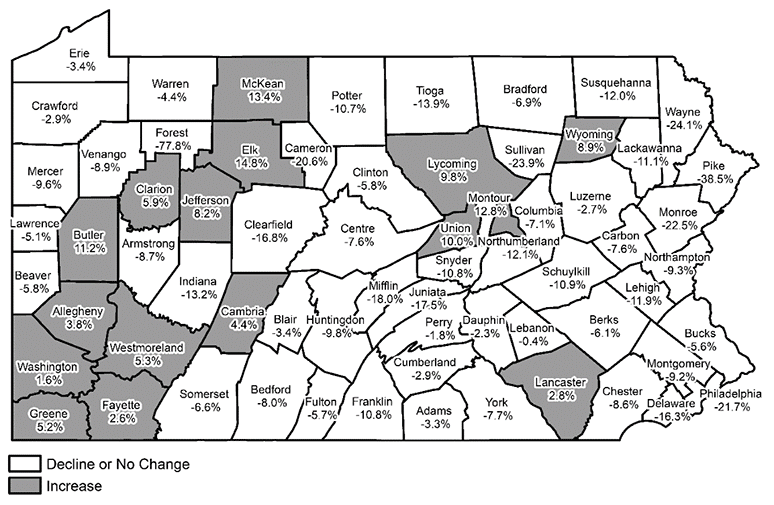
Data sources: 2010 Census and 2017, 5-year average, American Community Survey, U.S. Census Bureau.
Characteristics of Young Adult Homeowners, 2017
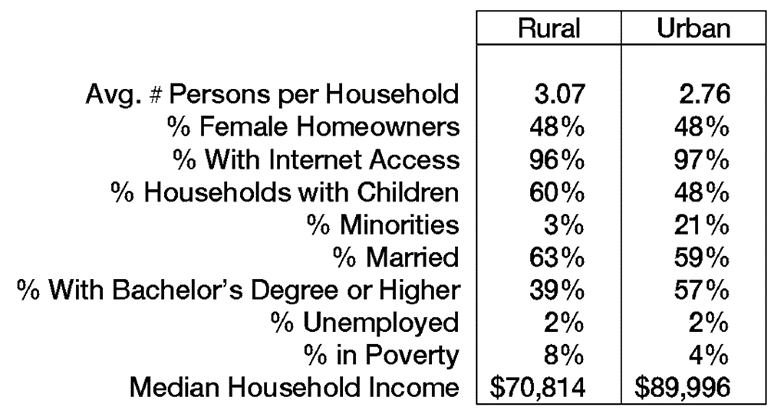
Data source: 2017, 1-year average, Public Use Microdata Sample, American Community Survey. U.S. Census Bureau.
First-time Homebuyers Under 35 Years Old in Rural and Urban PA, 2011 to 2017
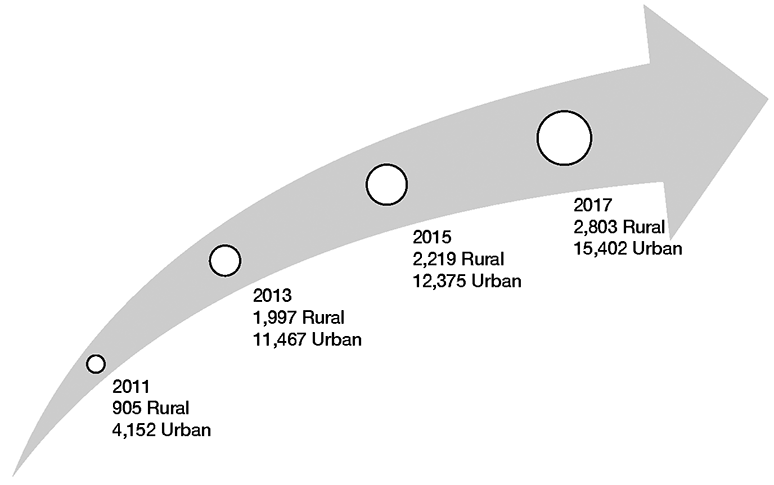
Data source: Federal Housing Finance Agency (FHFA), Enterprise Public Use Database, Single-Family Properties, Census Tract File. A first-time buyer, is defined by FHFA as a homebuyer who intends to live in the purchased home and who has not owned a home in the past 3 years.
Rural and Urban Homeownership Rates by Age, 2017
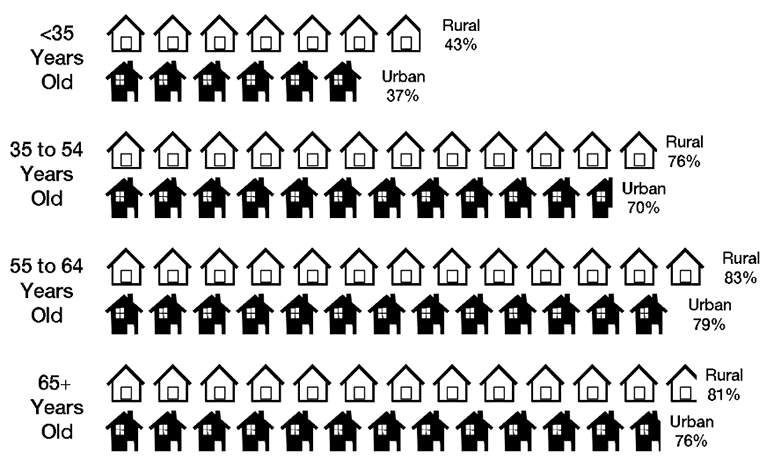
Data source: 2017, 5-year average, American Community Survey. U.S. Census Bureau.
Fast 5: Municipalities with a High Percentage (15%+) of Homeowners Under Age 35 (2017)
1) 64 percent are boroughs; 35 percent are townships; and 1 percent are cities.
2) $172,500 is the average home value, or $40,900 lower than the statewide average of $213,400.
3) 3,025 is the average municipal population. The statewide average is 5,002.
4) 19 percent of the population is non-white and/or Hispanic. Statewide, 23 percent of the population is non-white and/or Hispanic.
5) $66,586 is the average household income, or more than $11,600 below the statewide average of $78,192.
Medication-Assisted Treatment
Research Examines Availability of Services in Rural Pennsylvania
Drug overdoses killed nearly 72,000 Americans in 2017, with 58 percent involving a prescription or illicit opioid. According to 2018 data from the Centers for Disease Control and Prevention (CDC), overdose deaths have increased in all categories of drugs examined for men and women, people ages 15 and older, all races and ethnicities, and across all geographic areas.
The opioid crisis has impacted rural areas especially hard. According to 2017 data from the CDC, from 1999 to 2015, there was a rising death rate of drug overdoses in rural areas, with a prevalence rate that increased 325 percent, contrasting with the increase in the urban rate of 198 percent.
To help address the crisis, the CDC recommends creating better access to evidence-based substance abuse treatment, which includes Medication-Assisted Treatment (MAT).
To assess the barriers and opportunities that exist to expand MAT services in Pennsylvania, Dr. Harry D. Holt, Dr. Matin Katirai, and Dr. Whitney Katirai of West Chester University of Pennsylvania conducted a study in 2017-2018 that identified areas in Pennsylvania, particularly rural areas, that are underserved by MAT services. The study, sponsored by the Center for Rural Pennsylvania, also identified salient themes from MAT clinic administrators regarding barriers and opportunities, and assessed state and federal policies for their impact on MAT services.
The researchers used secondary data from the Pennsylvania Department of Drug and Alcohol Programs, a literature review, Geographic Information Systems (GIS), and surveys and interviews with MAT clinic administrators to complete the research.
What is MAT
MAT includes the use of methadone, buprenorphine, Suboxone, naloxone, and naltrexone in residential, behavioral, or outpatient programs, hospitals, and jails and prisons to help individuals suffering from opioid addiction to overcome withdrawal symptoms, cravings, and potential overdose.
Access to MAT
The research findings indicated there is substantial coverage for MAT services in the western portion of Pennsylvania. There is only some coverage in the central and eastern portions of the state, and a lack of MAT services along the northern and southern portions of Pennsylvania.
The research also found that those who seek emergency care and long-term treatment for opioids and who live in rural areas of Pennsylvania have limited access to care. Mobile clinics and outreach teams that provide MAT services could potentially be a major source of care in Pennsylvania given the state’s rural nature.
Other barriers to accessing MAT services are lack of childcare and housing, lack of transportation, limited private insurance coverage, and limited funding for MAT services.
Another barrier faced by patients is the stigma against those with opioid use disorder and the use of MAT services.
Expanding MAT
The research found that many opportunities for expanding MAT services exist. These include directing additional funding from SCAs to MAT services, addressing stigma through education, and increasing childcare and public transportation services. The number and hours of operation for MAT clinics could also be increased. Pennsylvania county drug courts should allow MAT services to be provided to those drug court participants who have medically prescribed and monitored MAT plans.
Finally, strict enforcement of insurance regulations by the state could increase coverage for MAT services.
Report Available
For a copy of the report, The Availability of Medication-Assisted Treatment for Opioid Addiction in Pennsylvania, visit the Center’s website at www.rural.palegislature.us.
Just the Facts: Bankruptcies
The number of bankruptcies filed in Pennsylvania decreased from 2017 to 2018, according to data from the Administrative Office of the U.S. Courts. In 2018, 5,718 bankruptcies were filed in rural Pennsylvania, a 5 percent decline from 2017, when 6,033 were filed.
In urban Pennsylvania, 15,807 bankruptcies were filed in 2018, a 4 percent decline from 2017, when 16,477 were filed.
The bankruptcy rates were identical in rural and urban Pennsylvania at168 filings for every 100,000 residents.
In both rural and urban Pennsylvania, the majority of bankruptcy filings in 2018 were for consumer debt (97 percent in rural and 96 percent in urban). Business fillings accounted for 3 percent of the rural filings and 4 percent of the urban filings. Consumer debt is debt incurred by an individual primarily for a personal, family, or household purpose. Business debt is debt from a corporation or partnership, or debt related to the operation of a business.
In 2018, the three counties with the highest number of bankruptcy filings per capita were Pike, Monroe, and Fayette counties. In each of these counties, the bankruptcy rate was greater than 300 filings per 100,000 residents. The three counties with lowest rates were Lycoming, Centre, and Union counties. Each of these counties had a rate of fewer than 65 filings per 100,000 residents.
Nationwide, in 2018, there were 764,975 bankruptcy filings. From 2017 to 2018, the number of filings decreased 2 percent. During this period, 19 states had an increase in bankruptcy filings and 31, including Pennsylvania, had a decrease in filings.
The national bankruptcy rate was 235 filings per 100,000 residents. Among all 50 states, Pennsylvania had the 35th lowest rate. The three states with the highest number of filings were Alabama, Tennessee, and Georgia, each with a rate of more than 440 filings per 100,000 residents. The three states with the lowest rates were North Dakota, Vermont, and Alaska, each with a rate of fewer than 105 per 100,000 residents.
The Census is Hiring! Jobs Available to Assist with 2020 Census
The U.S. Census Bureau is recruiting thousands of people across the country to assist with the 2020 Census count.
A variety of temporary jobs, including census takers, recruiting assistants, office staff, and supervisory staff, are available. To be eligible, you must be at least 18 years old, have a valid Social Security number, and be a U.S. citizen. Candidates must complete an online job application, which includes assessment questions about your education, work, and other experience.
For more information or to apply, click here.
